Croes Sant Brynach | |
 | |
 | |
| Location | St Brynach Church, Nevern |
|---|---|
The Saint Brynach Cross (Welsh : Croes Sant Brynach) or Nevern Cross (Welsh : Croes Nanhyfer) is a 10th or 11th century stone cross at St Brynach's church, Nevern.
Croes Sant Brynach | |
 | |
 | |
| Location | St Brynach Church, Nevern |
|---|---|
The Saint Brynach Cross (Welsh : Croes Sant Brynach) or Nevern Cross (Welsh : Croes Nanhyfer) is a 10th or 11th century stone cross at St Brynach's church, Nevern.
The cross is thought to date from the 10th or 11th century. Legend has it that the first cuckoo of the year in West Wales stands on the top of the cross and sings on the day of St Brynach's feast on the 7th of April. [1]
The cross stands at 3.72m tall in the churchyard of St Brynach's Church and was first noted to be in its current position in 1603 by George Owen of Henllys. [2]
The cross is made of Ordovician stone and of two separate pieces, the rectangular shaft and the cross-head.The cross shows interlaced and fret patterns carved into the rock which have viking influence. An inscription "DNS" on the western side of the cross translates as "Lord" and an inscription on the eastern face translates as "Hauen". [2]
It is likely that both the Saint Brynach Cross and the Carew Cross were made in the same monastery workshop and date to the second half of the 10th century or early 11th century. [3]
The Saint Brynach Cross, Carew Cross and Maen Achwyfan are considered the three outstanding high crosses of Wales. [4]
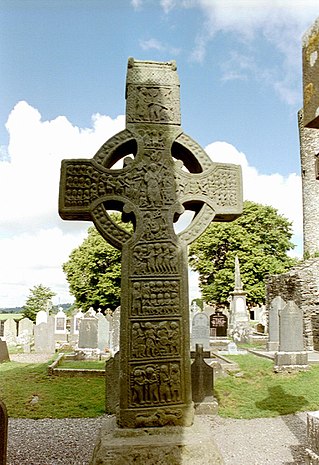
A high cross or standing cross is a free-standing Christian cross made of stone and often richly decorated. There was a unique Early Medieval tradition in Ireland and Britain of raising large sculpted stone crosses, usually outdoors. These probably developed from earlier traditions using wood, perhaps with metalwork attachments, and earlier pagan Celtic memorial stones; the Pictish stones of Scotland may also have influenced the form. The earliest surviving examples seem to come from the territory of the Anglo-Saxon kingdom of Northumbria, which had been converted to Christianity by Irish missionaries; it remains unclear whether the form first developed in Ireland or Britain.

Nevern is both a parish and a community in Pembrokeshire, Wales. The community includes the settlements of Felindre Farchog, Monington, Moylgrove and Bayvil. The small village lies in the Nevern valley near the Preseli Hills of the Pembrokeshire Coast National Park 2 miles (3 km) east of Newport on the B4582 road.
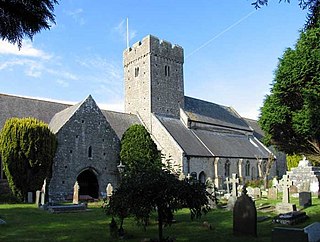
St Illtyd's Church is a church complex in Llantwit Major, Vale of Glamorgan, southeast Wales. It is located at the site of the oldest college in the United Kingdom, once believed to have been founded as Côr Tewdws c. AD 395 by the Roman Emperor Theodosius II. It is now generally accepted as having been founded by St. Illtud c. AD 508, from whom it derives its name. The current church building was built in the 11th century by the Normans, with portions being rebuilt in the 13th and 15th centuries. The church building is one of the oldest and best-known parish churches in Wales. It is a grade I listed building, or building of exceptional interest, and has been called both the "Westminster Abbey of Wales" for its unique collection of carved stones and effigies, and "the most beautiful church in Wales."
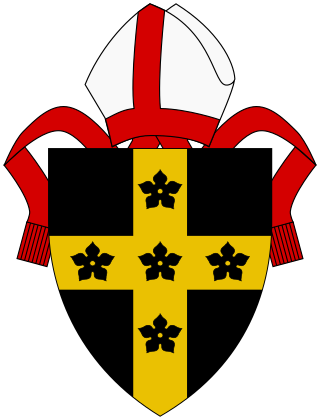
The Diocese of St Davids is a diocese of the Church in Wales, a church of the Anglican Communion. The diocese covers the historic extent of Ceredigion, Carmarthenshire and Pembrokeshire, together with a small part of western Glamorgan. The episcopal see is the Cathedral Church of St David in the City of St Davids, Pembrokeshire. The present cathedral, which was begun in 1181, stands on the site of a monastery founded in the 6th century by Saint David.
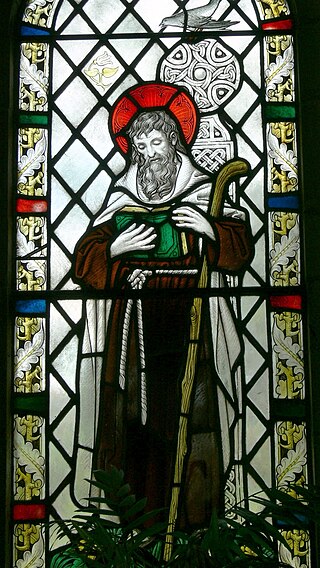
Saint Brynach was a 6th-century Welsh saint. He is traditionally associated with Pembrokeshire, where several churches are dedicated to him.

Penmachno is a village in the isolated upland Machno valley, 4 miles (6 km) south of Betws-y-Coed in the county of Conwy, North Wales. The B4406 road runs through part of the village. The village is at the confluence of the Glasgwm and Machno rivers. It has a five-arched, stone bridge dating from 1785. The village has been referred to as Pennant Machno, Llandudclyd and Llan dutchyd in historical sources.

Carew is a village, parish and community on an inlet of Milford Haven in the former Hundred of Narberth, Pembrokeshire, West Wales, 4 miles (6.4 km) east of Pembroke. The eastern part of the parish is in the Pembrokeshire Coast National Park.

Celtic inscribed stones are stone monuments dating from 400 to 1000 AD which have inscriptions in Celtic or Latin text. These can be written in Ogham or Roman letters. Some stones have both Ogham and Roman inscriptions. The stones are found in Ireland, Scotland, Wales, Brittany, the Isle of Man, and parts of western England. Most seem to be grave-markers or memorials to a dead individual.

St Melangell's Church is a Grade I listed medieval building of the Church in Wales located in the former village of Pennant Melangell, in the Tanat Valley, Powys, Wales. The church was founded around the 8th century to commemorate the reputed grave of Melangell, a hermit and abbess who founded a convent and sanctuary in the area. The current church was built in the 12th century and the oldest documentation of it dates to the 13th century. The building has been renovated several times, including major restoration work in the 19th and 20th centuries. In the 1980s the church was in danger of demolition, but under new leadership it was renovated and a cancer ministry was started. In 1958, and again between 1987 and 1994, the site was subject to major archaeological excavations, which uncovered information about prehistoric and medieval activity at Pennant Melangell, including evidence of Bronze Age burials.
Carew Cross is an 11th-century Grade I listed monument in the village of Carew, Pembrokeshire, Wales.

St Pabo's Church, Llanbabo is a medieval church in Llanbabo, in Anglesey, North Wales. Much of the church dates to the 12th century, and it is regarded as a good example of a church of its period that has retained many aspects of its original fabric. The church houses a tombstone slab from the 14th century, depicting a king with crown and sceptre, bearing the name of Pabo Post Prydain, the reputed founder of the church. However, there is no evidence that Pabo, a 5th-century prince, lived in the area and the tradition that he founded the church has little supporting basis.
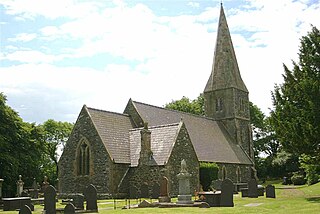
St Caffo's Church, Llangaffo is a 19th-century church, in the south of Anglesey, north Wales, about 5 miles (8.0 km) from the county town, Llangefni. It was constructed in 1846 to replace the previous medieval church in the village of Llangaffo. The new building includes a number of monuments from the old church, and has a spire which is a prominent local landmark. The churchyard has part of a stone cross dating from the 9th or 10th century, and some gravestones from the 9th to 11th centuries. It is dedicated to St Caffo, a 6th-century martyr who was killed in the vicinity.
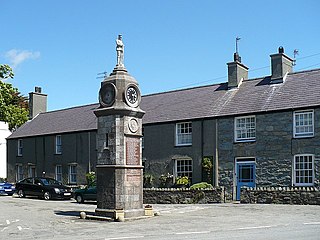
Llanfechell is a village in Anglesey, Wales. It is the largest of several small villages and dispersed settlements that make up Mechell Community Council area. It is 11 miles (18 km) east of Holyhead, and 5.6 miles (9 km) west of Amlwch, in the north of the island.
Cynfarwy was a Christian in the 7th century about whom little is known. He was venerated by the early church in Wales as a saint, although he was never formally canonised. St Cynfarwy's Church in Anglesey is dedicated to him, and his name is also preserved in the name of the settlement around the church, Llechgynfarwy. His feast day is in November, although the date varies between sources.

Margam Stones Museum is a small Victorian schoolhouse near Port Talbot, South Wales, which now provides a home for one of the most important collections of Celtic stone crosses in Britain. All originally found within the locality of Margam, and mostly assembled as a collection in the 19th century, they provide enduring testimony to a Welsh Christian culture between the 6th and 16th centuries. The striking Cross of Conbelin is the most celebrated example. From around 1000 AD, it is a huge disc cross with Celtic interlace and plaitwork patterns, figurative scenes including a hunting scene, and inscriptions telling us who made it and who erected it. There are 17 early Christian stones, plus 11 memorials and other stones from the post-Norman periods. The museum is run by Cadw, the Welsh historic sites agency, and is close to Margam Abbey Church and the ruins of the Abbey buildings.

Saint Einion Frenin was a late 5th and early 6th century Welsh confessor and saint of the Celtic Church. His feast day was originally given as 9 February, although this had moved to the 10th or 12th by the 16th century and is no longer observed by either the Anglican or Catholic church in Wales.

The archaeology of Wales is the study of human occupation within the country of Wales which has been occupied by modern humans since 225,000 BCE, with continuous occupation from 9,000 BCE. Analysis of the sites, artefacts and other archaeological data within Wales details its complex social landscape and evolution from Prehistoric times to the Industrial period. This study is undertaken by academic institutions, consultancies, charities as well as government organisations.

St Dochdwy's Church is a historic listed church in the village of Llandough, near Penarth in the Vale of Glamorgan, Wales.
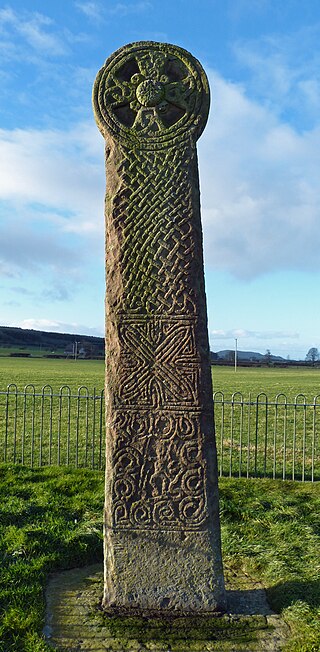
Maen Achwyfan or Maen Achwyfan Cross, located near the village of Whitford in Flintshire, Wales, is a high cross. Standing 3.4 metres (11 ft) high, it is the tallest wheel cross in Britain, and is a Scheduled monument.

St Cynog's Church is an active parish church in the village of Defynnog, Powys, Wales. The dedication is to Saint Cynog, one of the 24 children of Brychan, a legendary 5th-century king of Brycheiniog. Dating from the 15th century, with earlier elements, the church was restored in the late 19th century. The churchyard is notable for its collection of ancient yew trees, the Defynnog Yew which is among the oldest in Britain. St Cynog's is designated by Cadw as a Grade I listed building.